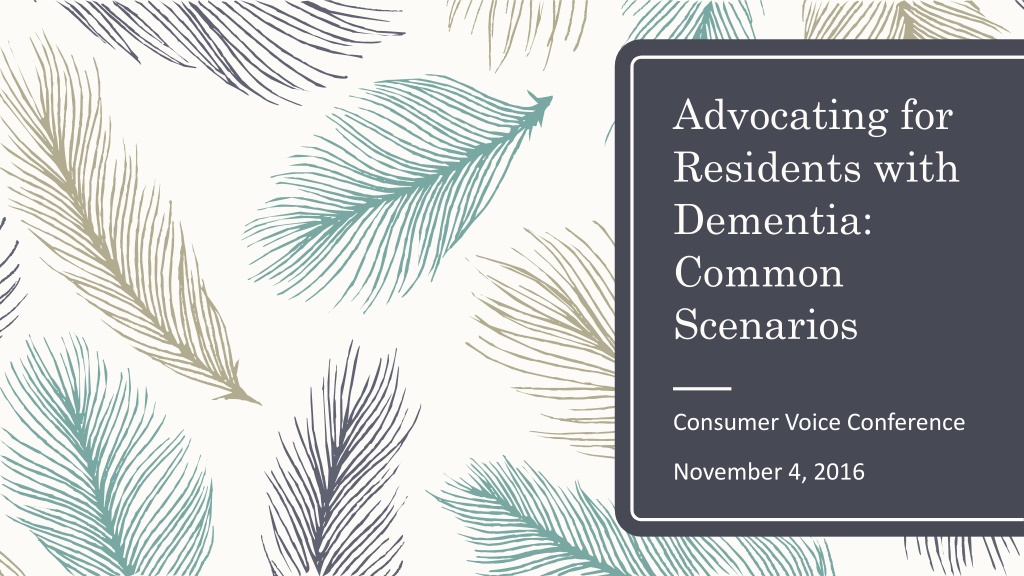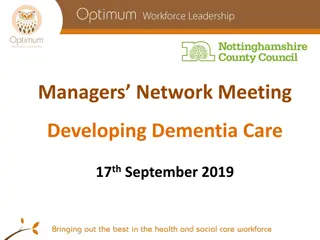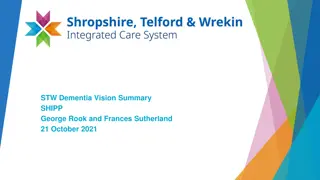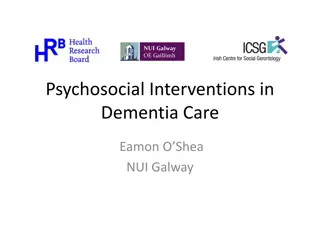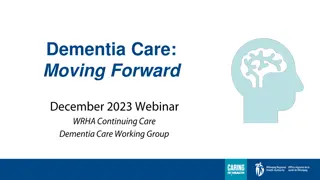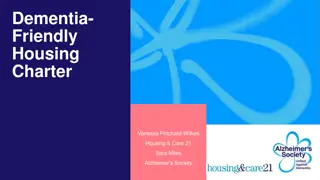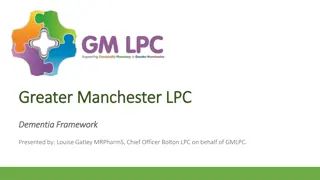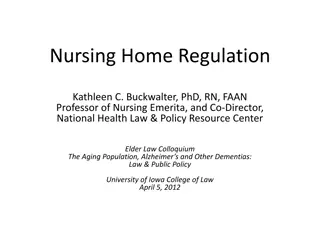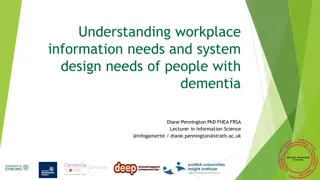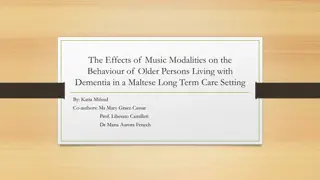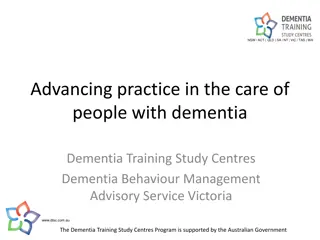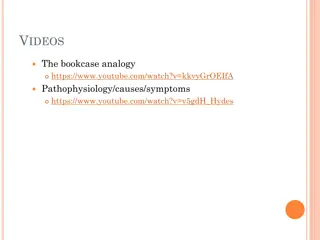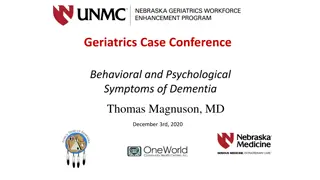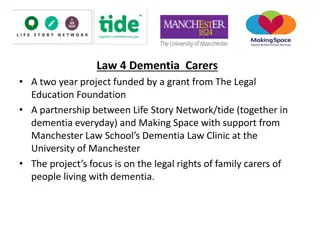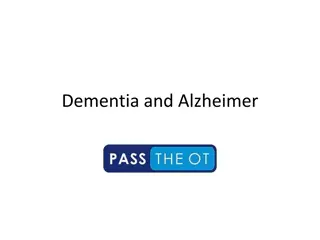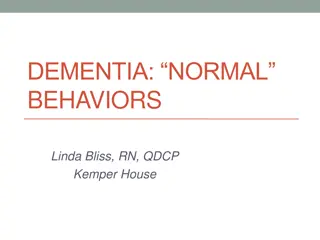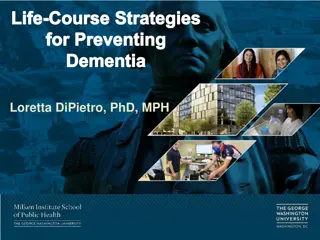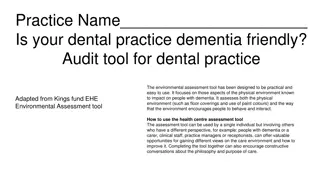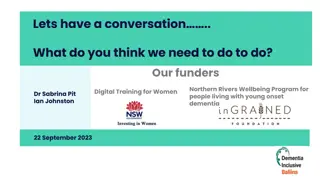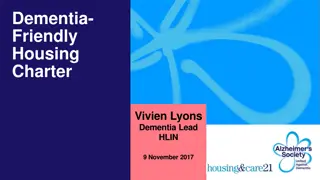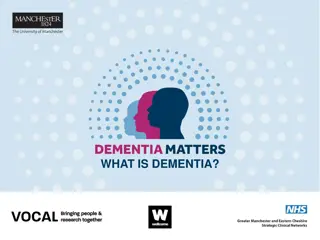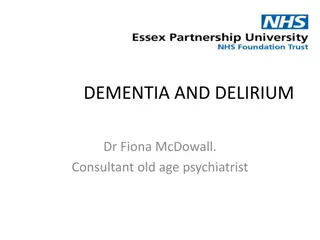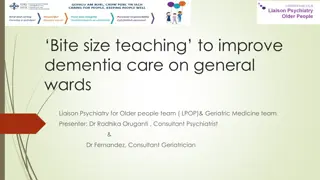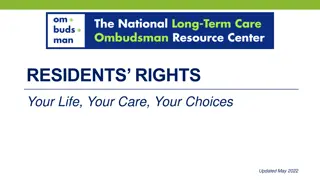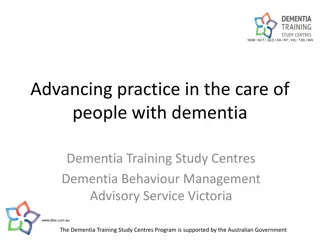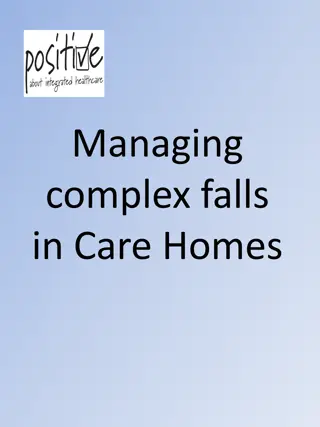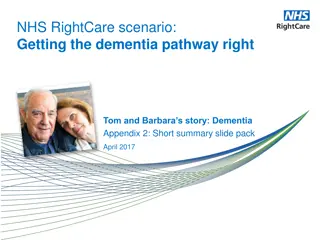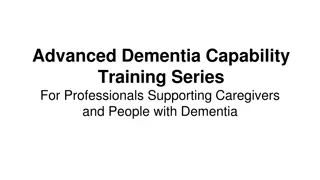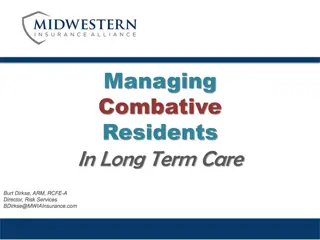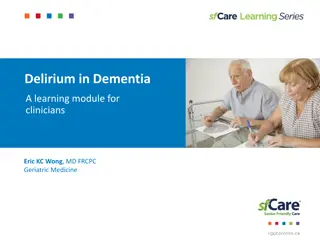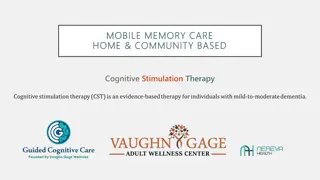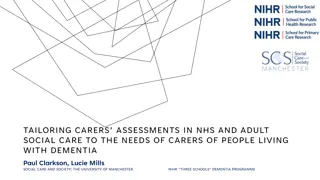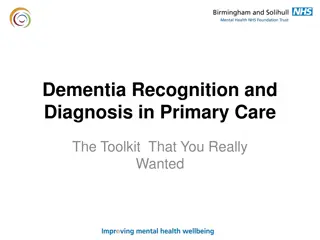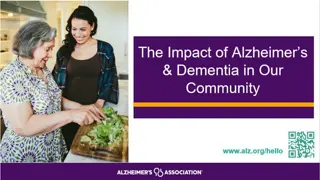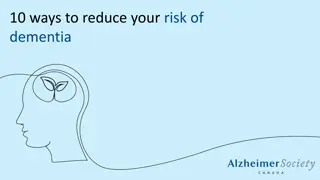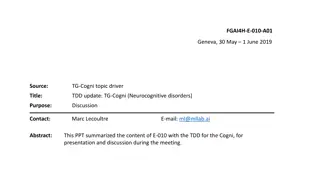Enhancing Care for Residents with Dementia: Practical Strategies and Insights
Explore the nuances of dementia care through understanding various forms of dementia, effective communication techniques, and advocating for tailored care practices. Delve into real-life case examples and root causes of poor care, emphasizing the crucial role of person-centered approaches. Discover the different types of dementia and the importance of inclusive care planning, while gaining valuable insights on how to relate to individuals with dementia positively and empower their sense of identity and worth.
Download Presentation

Please find below an Image/Link to download the presentation.
The content on the website is provided AS IS for your information and personal use only. It may not be sold, licensed, or shared on other websites without obtaining consent from the author. Download presentation by click this link. If you encounter any issues during the download, it is possible that the publisher has removed the file from their server.
E N D
Presentation Transcript
Advocating for Residents with Dementia: Common Scenarios Consumer Voice Conference November 4, 2016
Objectives 1. Understanding the many forms of dementia 2. Communicating with residents with dementia 3. Advocating for alternative care practices to address common care issues for residents with dementia
Root Causes of Poor Care Lack of person-centered care Inadequate assessment & care plan issues Insufficient staffing
Case Example We re in a home where Charlene lives Charlene moved in less than a year ago She is non-verbal She is incontinent of bowel and bladder She is resistive to care at times And she rummages through her roommate s belongings
Meet Charlene!
Dementia Defined Dementia is an umbrella term used to describe a group of symptoms affecting memory, thinking, and social abilities. Despite the large population of people with dementia, many nursing homes and their staff are not prepared for the challenges of caring for those people.
Types of Dementia Alzheimer s Disease Frontotemporal Dementia Vascular Dementia Creutzfeldt-Jakob Disease Dementia with Lewy Bodies Normal Pressure Hydrocephalus Parkinson s Disease Huntington s Disease Wernicke-Korsakoff Syndrome
Care Planning Point Remember to encourage all residents to attend their care plan meeting. Their presence reminds us and staff to keep the focus on their care.
How you relate to us has a big impact on the course of the disease. You can restore our personhood and give us a sense of being needed and valued Give us reassurances, hugs, support, a meaning in life. Value us for what we can still do and be, and make sure we retain our social networks. - Christine Bryden
Communication Words Matter
Person with Dementia Recommended Words: Words to Avoid: Rationale: Person living with dementia Resident with dementia Resident Words listed to avoid are considered derogatory and offensive and should not be used. Patient Sufferer or Victim Demented Senile Afflicted Wanderer Sundowner Feeder Losing his/her mind Loss of self PWD The use of acronyms in research work infers a lack of sensitivity and respect for the personhood of an individual or group of people. Use words as a sign of respect.
Behavior is a Communication Recommended Words: Words to Avoid: Rationale: Behavior problem Challenging behavior Difficult behaviors Behavioral and psychological symptoms of dementia Vocalizer Behavioral expressions are expressions of an unmet need, such as pain, hunger, thirst, boredom, loneliness, or an underlying medical condition. Understanding behaviors from this broader perspective aids in uncovering the root cause of the behavior being expressed. Expressions of unmet need Behavior expressions Behaviors expressed by a person living with dementia Aggressor
Common Scenarios Behavior Expressed by Persons Living with Dementia
Repetition How can we advocate for a resident who repeats words or actions? Ask if the facility has looked for a reason for the repetition. Remind staff to focus on the emotion. Can staff turn the action or behavior into an activity? Remind staff to stay calm and be patient. Ask staff to provide an answer. Advocate that the staff engage the person in an activity.
Yelling Poorly managed pain can result in behavioral symptoms and lead to the unnecessary use of psychotropic medications. Residents who yell and moan are giving clues to their needs. When working with a resident who moans or yells, it is important to find out whether they have had a recent pain assessment. Pain assessment should occur routinely, especially when residents have conditions likely to result in pain or if the resident indicates in any manner that they have pain. For residents who cannot verbally communicate, direct observation by staff can help identify pain and pain behaviors. Signs of pain included labored breathing, grimacing, rigid posture and clenched fists, and loud moaning, groaning, or crying.
False Ideas Ted Talk : http://www.tedmed.com/talks/show?id=526821 If a resident has reported to you that there is a monkey living in her ceiling, or his daughter has stolen his fortune, or there are scary men who roam the hallways late at night, it is important to reassure the resident and try to understand their reality. Let the resident know you care without trying to argue or convince them they are wrong. It is important that residents who experience extremely troubling delusions or hallucinations receive proper medical treatment. Treatment should start with non-drug approaches, but could require medication.
Residents Who Wander Residents with dementia often wander some estimates suggest more than half of people with dementia wander at some point. While residents who wander often look as though they are walking aimlessly, wandering is very often a response to an unmet need. Residents who wander may be looking for human contact or the toilet, or they may be experiencing hunger, thirst, noise, or pain. Sometimes, residents wander as an attempt to follow an old routine, such as going to work or picking up their children. Wandering is often also referred to as exit-seeking because many residents appear to be trying to leave the nursing home. While most residents who wander are not actively trying to leave the facility, they may experience harm as a result of their wandering. Residents who wander may become locked out of the nursing home while searching for a bathroom. They may wander into another resident s room and be yelled at or pushed out. Addressing a resident s wandering can be challenging, but nursing homes must ensure the safety of residents who wander and the privacy of residents who find wandering residents in their rooms.
Wandering Residents who want to go home Ombudsmen frequently encounter residents who ask for help going home. Oftentimes, for residents with dementia, the desire is an indication that the resident is not comfortable in the nursing home. The request is for a feeling of home, not always a specific desire to be back in the house they once lived. For these residents, an ombudsman can work with family to identify routines and personal items that can be brought back into their lives in the nursing home.
Residents Who Wander Preventing Wandering Clearly label important doors: Help residents with dementia find the bathroom by clearly labeling the restroom door with words and pictures. Help residents find their rooms with pictures and personal items in a frame or shadowbox outside their door. Disguise wrong doors: Camouflaging the door to the kitchen or stairwell can help residents avoid entering unsafe locations. The door could be made to look like a wall or bookshelf. Exit doors may also be disguised, but facilities should check with fire marshals to determine what is permitted. Provide activity stations : Tables with activity items may distract a resident from exit-seeking. The table could have laundry, cleaning cloths, simple craft items, or other items.
Residents Who Wander Preventing Wandering Black mats in doorways: Black mats in front of exit doors can be a way to deter residents with dementia. Most people with dementia interpret the mat as a deep hole and avoid the area. Facilities could also put mats in front of other resident s doors, as long as the residents occupying the room agree. Alarms: Silent alarms can be used to alert staff when a particular door is open without causing stress to residents. Alarm-delayed exit doors are another option, which alarm when someone pushes on the door and open after it is pushed for some time. Staff training: All staff should know how to redirect a resident who has wandered into an inappropriate location.
Wandering Safe wandering Wandering cannot usually be resolved by stopping the behavior. It is important that facilities take these steps to create a safe environment for residents who wander instead of using medication that causes residents to become lethargic or sleepy. Safe wandering can be achieved through the suggestions above or through the creation of safe wandering areas. An enclosed outdoor courtyard can be an option, and hallways can be better designed to keep residents who wander safe.
Anxiety & Agitation Possible Causes Investigate Further The environment is too stimulating. The resident is experiencing pain. Can the facility simplify the environment? Ask the facility how they evaluate the resident for pain. Can the resident communicate their pain? Advocate that the facility maintain a consistent routine and consider consistent staffing assignments. Care partners should use a positive, matter of fact, calm approach. Does the facility need the ombudsman to provide an in service on residents rights and elder abuse? There is a change of routine or care partner. The care partner is agitated.
Anxiety & Agitation Possible Causes Investigate Further The resident is experiencing too many demands. Advocate that care partners simplify their instructions and avoid questions that require memory. Ask the facility what activities they plan for residents with dementia. Advocate for the resident to be included in activities that he or she is interested in. The care partner should not argue with the resident s reality, but reassure the resident that they are safe. Advocate that the facility order an evaluation of the resident s medications. The resident is bored. The resident s dementia causes misinterpretation. The resident is experiencing side effects from medications.
Care Planning Point Ask questions in the care plan meeting about what triggers have been identified and how they can be managed. Residents who experience anxiety during care activities should be accommodated to avoid further anxiety or agitation.
Bathing Without a Battle For residents with dementia, bathing can be extremely confusing, frightening, and traumatic. Bathing is necessary to prevent skin breakdown and infection, but residents always have the right to refuse care. Rather than using a resident s refusal as an opportunity to avoid care, there are many ways facilities can decrease anxiety for residents who refuse or fight bathing care. http://bathingwithoutabattle.unc.edu/
Bathing Without a Battle Cause of Anxiety The resident is cold and uncomfortable. Possible Solution Keep the room and water temperatures comfortable. Suggest the facility install an extra heater in the bathroom to keep the air as warm as the water. Suggest modifying the shower chair to be cushioned and more comfortable. Undress the person in the bathroom. As the resident is undressed, cover them with a bath blanket. Suggest to the facility that they ask residents what time they would like to have a bath, and whether they would like a tub bath, shower, or bed bath. If the resident cannot answer, the facility may ask family or observe the resident s preferences. The resident is uneasy being so exposed. The resident feels like they have no control over their care.
Bathing Without a Battle Cause of Anxiety The resident is overwhelmed and confused, or afraid of bath time. Possible Solution Advocate for the facility to use consistent staffing so that residents are familiar with their care partner. Employing a bath nurse aide means residents do not know who is undressing and touching them during their bath time. Ask the care partner to fill the tub before bringing the resident into the bathroom. The room will be warmer and considerably quieter. Suggest that care partners avoid background noises and conversations and instead speak calmly and positively to the resident, using reassuring phrases. Advocate for the resident to participate in their bath the care partner can give them a washcloth or put their hand over the resident s to remind them of what they are doing.
Bathing Without a Battle Cause of Anxiety The resident is overwhelmed and confused, or afraid of bath time. Possible Solution Ask care partners to stay focused on one part at a time if two aides are providing care, they should not each wash a body part at once. Advocate that the facility use a sock or pillowcase over the showerhead to decrease the force of the spray. Suggest the facility decorate the bathroom in a homelike fashion, not a sterile room. Music and aromatherapy oils can be soothing. Ask the facility to show the resident the bathroom when they are not going to the bath to help them become acquainted.
Resident to Resident Aggression Resident to resident aggression (RRA) is a negative and aggressive physical, sexual, or verbal interaction between long-term care residents that is considered unwelcome. RRA has a high potential to cause physical or psychological distress in the person being mistreated. Examples of resident to resident aggression include: Biting Bullying Destroying property Grabbing Hitting Inappropriate touching Kicking Physical sexual advances Pushing Racial/ethnic slurs Scratching Screaming Sexual harassment Spitting Taking personal items Threatening Throwing things
Resident to Resident Aggression Risk Factors: Resident Characteristics Residents with significant cognitive impairments, such as dementia and mental illness Residents with behavioral symptoms related to dementia or other cognitive impairment that may be disruptive to others (yelling, repetitive behaviors, calling for help, wandering into others rooms) Residents with a history of aggressive behavior and/or negative interactions with others
Resident to Resident Aggression Risk Factors: Facility Characteristics Inadequate number of staff Lack of staff training about individualized care in order to support residents needs, capabilities, and rights (e.g., resident-centered care, abuse prevention, care for those with limited capacity, dementia, and mental health needs) Lack of meaningful activities & engagement Crowded common areas (too many residents in one room, equipment/obstacles in common areas) Excessive noise
Care Planning Point When investigating a complaint of resident to resident (RRA), a facility may place a resident on 1- on-1 or 15 minute checks for 24 hours. A care plan meeting may be necessary to address triggers or causes of the RRA. Ask what the facility intends to do after that 24 hour period to ensure resident safety every day.
Care Planning Point If the facility reports they have tried to identify a pattern and found nothing, probe further. Who observed the resident? What notes were made? What was the observer watching for, and what tool did they use to record their findings?
Resident to Resident Aggression Recommendations to Prevent & Reduce Incidents of RRA: Environmental Considerations Clear common areas of clutter Reduce noise and overcrowding Provide areas for supervised, unrestricted, safe movement. Identify environmental influences on behavior and adjust accordingly (temperature, lighting). Promote meaningful activities and opportunities for engagement for all residents based on individual needs, interests, and abilities.
Resident to Resident Aggression Recommendations to Prevent & Reduce Incidents of RRA: Care Practices Develop comprehensive care plans which provide individualized, resident- centered care. Implement best practices for supporting residents with behaviors. Identify residents with risk factors for RRA and develop care plans to meet their needs. Monitor their care closely. Identify root causes of behavior symptoms and reduce or eliminate those causes (pain, boredom, loneliness)
Resident to Resident Aggression Recommendations to Prevent & Reduce Incidents of RRA: Staffing Practices Train facility staff on person-centered care, dementia, and mental illness. Develop policies regarding how to prevent, recognize, respond, report, and document RRA. Implement consistent staffing assignments so residents and staff are more comfortable with each other and staff are more familiar with resident needs and changes in behavior. Ensure adequate staffing levels in order to meet resident needs and provide supervision.
Care Planning Point Has the facility discussed the behavior with their psychiatric or behavioral consultant?
Interviewing Residents with Dementia Find a calm environment for your interview. Consider finding an empty conference room or quiet day room. Eliminate distractions and competing noise. Reintroduce yourself and your role. Avoid asking a resident if they remember you. Be sure to capture the resident s attention before starting your interview. Speak only when the resident s attention is directed toward you. Sit and speak face to face. Do not speak directly into a resident s ear they won t be able to read your lips or facial expression. Speak clearly and on an adult level. Don t yell it makes it harder to read your lips and facial expression. Give concise questions or directions. Only ask one question at a time. Repeat information as necessary, but be sure to allow her time to hear your question, interpret your words, formulate a response, and verbalize her answer.
Care Planning Point Model good interviewing for facility staff. In care plan meetings, ask the resident what they want and wait for their response.
Advocates Response Investigate further by asking the following questions: What is the behavior? Is it harmful? To whom? Has the facility monitored the behavior to find a cause? What triggers the behavior environment, time, a particular person? Other triggers could include vision and hearing impairments, hunger, thirst, pain, lack of social interaction, or inappropriate strategies for care by staff. Once you have found out what the behavior is, find out what the facility has done to address the behaviors. Has the facility assessed the resident s pain?
Advocates Response Has the facility reviewed the resident s medication? Does the resident need to be assessed? Are the person s needs being met? Consider needs beyond food, water, and medication. Consider psychosocial needs as well. Has the facility adapted the environment for the resident? Has the staff tried changing their approach or reaction? A change in approach or care plan must be applied consistently and evaluated regularly. The answer may not be easy, and the solution for one resident may not work for another. It is important that ombudsmen continue to advocate for the resident to get care for their behaviors.
Care Planning Point Before a resident is prescribed a psychoactive drug, find out what non-drug treatments they have tried. Have they truly identified the cause of the behavior, or is the drug going to mask a resident s pain or needs?
Revised Federal Nursing Home Regulations On October 4, 2016, the final regulations for nursing homes participating in the Medicare/ Medicaid programs were published in the Federal Register. The finalized provisions reflect advances in the theory and practice of service delivery and safety, and implement sections of the Affordable Care Act (ACA). Person-Centered Care Baseline care plan Trauma informed care Quality and Highest Practicable Well-Being Implementation of Legislation including Section 6121 of ACA, dementia and abuse training Improving behavioral healthcare, and Safeguarding nursing home residents from the use of unnecessary psychotropic (antipsychotic) medications Strengthens requirements for discharge planning.
Staffing In 2001, DHHS released This report recommending a daily minimum standard of 4.1 hours of total nursing time (RN, LPN/vocational nurses, certified nursing assistant) and found that staffing levels falling below this minimum put nursing home residents at risk.
THANKS FOR JOINING US! Denise Kennedy, Bluegrass District LTCO denisekennedy@ombuddy.org Mark Burress, SLTCOP Regional Ombudsman markburress.ombuddy@gmail.com Sherry Culp, SLTCOP sherryculp@ombuddy.org For the manual Advocating for Residents with Dementia: Common Scenarios http://www.ombuddy.org/dementia-training-1/ Nursing Home Ombudsman Agency of the Bluegrass www.ombuddy.org 859-277-9215
